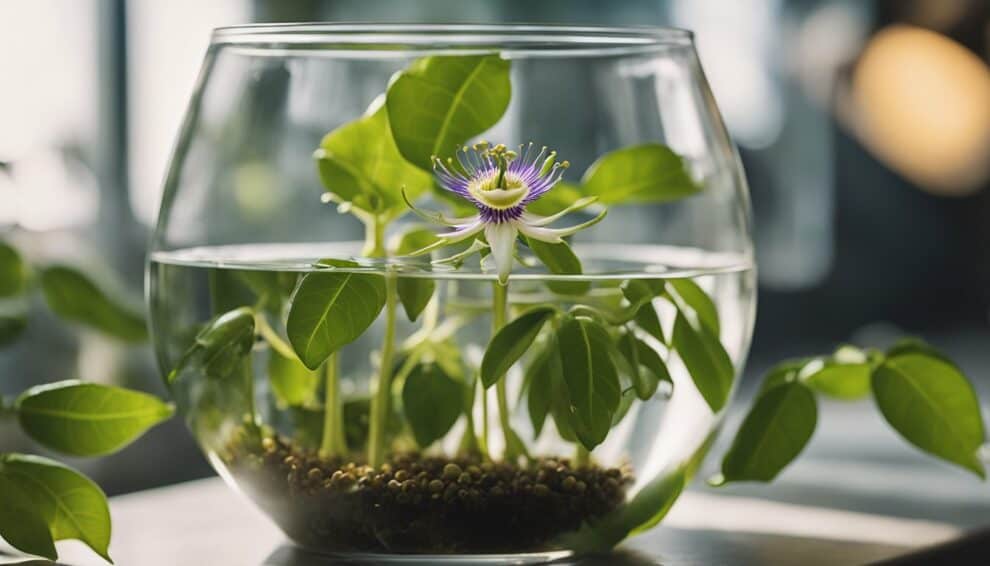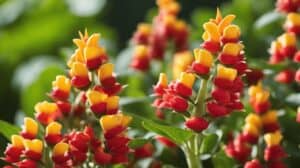Passion flowers, scientifically known as Passiflora spp., are beautiful and unique plants that can add a touch of exoticism to any garden.
These plants are known for their stunning and intricate flowers, which come in a range of colors and sizes.
Cultivating passion flowers can be a rewarding experience for any gardener, and with the right techniques, it can be a relatively simple process.

Propagation is one of the most important steps in cultivating passion flowers.
While there are many different methods for propagating these plants, some techniques are more effective than others.
For example, stem cuttings are a popular method for propagating passion flowers, as they are relatively easy to root and can produce new plants quickly.
Other methods, such as layering and seed propagation, can also be effective but may require more time and effort.
In this article, we will explore some of the best techniques for propagating passion flowers and provide simple, step-by-step instructions for each method.
Understanding Passion Flowers
Passion flowers (Passiflora spp.) are known for their unique and vibrant blooms, which are often used in ornamental gardens.
However, these plants also have a rich history and many varieties with different characteristics and uses.
History and Significance
Passion flowers are native to Central and South America, where they have been used for medicinal and cultural purposes for centuries.
The plant’s name comes from its association with the passion of Christ, as the flower’s unique anatomy was seen as a symbol of the crucifixion.
In addition to its cultural significance, passion flower has also been used for its medicinal properties.
The plant contains compounds that have been shown to have calming and sedative effects, making it a popular natural remedy for anxiety and insomnia.
Varieties of Passiflora
There are over 500 species of passion flower, each with its own unique characteristics and uses. Some common varieties include:
- Passiflora incarnata: Also known as maypop, this variety is native to the southeastern United States and is commonly used for its calming properties.
- Passiflora edulis: This variety produces edible fruit, commonly known as passion fruit, which is used in a variety of culinary applications.
- Passiflora caerulea: This variety is known for its striking blue and white flowers and is often used in ornamental gardens.
Passion flowers are also hybridized to create new varieties with different characteristics and appearances.
Overall, passion flowers are a fascinating and diverse group of plants with a rich history and many uses.
Whether you are interested in their cultural significance, medicinal properties, or ornamental value, there is sure to be a passion flower variety that suits your needs.
Cultivation Essentials

Choosing the Right Location
Passion flowers thrive in warm and sunny locations, making them an ideal choice for gardens in tropical and subtropical regions.
However, they can also be grown in cooler climates with some care and attention.
When choosing a location for your passion flower, make sure it receives at least six hours of direct sunlight each day.
Soil Preparation and Requirements
The soil for passion flower should be well-draining and rich in organic matter. A pH range of 6.0 to 7.5 is ideal for optimal growth.
Before planting, it is recommended to amend the soil with compost or well-rotted manure to improve the soil’s fertility and drainage.
This will help to ensure that the plant has enough nutrients to grow healthy and strong.
Planting Techniques
When planting passion flowers, it is important to dig a hole that is twice the size of the plant’s root ball.
Make sure to keep the plant’s crown at soil level and backfill the hole with soil, gently tamping it down as you go.
Water the plant thoroughly after planting and apply a layer of mulch around the base of the plant to help retain moisture and suppress weeds.
Passion flowers can also be propagated from cuttings. To do this, take a cutting from a healthy plant and dip the cut end into rooting hormone powder.
Plant the cutting in a well-draining potting mix, water it thoroughly, and place it in a warm and bright location.
Keep the soil moist but not waterlogged, and in a few weeks, the cutting should start to grow roots.
By following these simple steps, you can successfully cultivate passion flowers in your garden and enjoy their beautiful blooms for years to come.
Growth and Care

Passion flowers are relatively easy to grow, but they do require some care and attention.
Here are some simple steps to help you propagate and maintain your passion flower.
Watering and Feeding
Passion flowers need regular watering, especially during dry spells. However, they do not like to be waterlogged, so make sure the soil is well-drained.
They also benefit from regular feeding, especially during the growing season. Use a balanced fertilizer and follow the manufacturer’s instructions.
Pruning and Training
Passion flowers can become quite large and unruly if left to their own devices.
To keep them in check, prune them back in late winter or early spring, before new growth appears. This will encourage bushier growth and more flowers.
Passion flowers can also be trained to climb up trellises or walls. Simply tie the stems to the support with soft twine or plant ties.
Pest and Disease Management
Passion flowers are generally quite resistant to pests and diseases, but they can occasionally be affected by spider mites, aphids, or whiteflies.
If you notice any signs of infestation, treat the plant with an insecticidal soap or oil spray.
Passion flowers can also be affected by fungal diseases, such as powdery mildew or black spot.
To prevent these diseases, make sure the plant has good air circulation and avoid getting the leaves wet when watering.
If you do notice any signs of fungal disease, treat the plant with a fungicide spray.
By following these simple steps, you can enjoy beautiful passion flowers in your garden or home.
Propagation Methods

Passion flowers are beautiful and exotic plants that can be propagated using different methods. Here are three common methods:
Seed Propagation
Seed propagation is the most common method of propagating passion flowers. It is also the easiest and most reliable method.
The seeds can be collected from mature fruits and stored in a dry and cool place until the next planting season.
To plant the seeds, they should be soaked in water for 24 hours before planting them in a well-draining soil mix.
Keep the soil moist and warm until the seeds germinate, which usually takes about 2-3 weeks.
Once the seedlings are big enough, they can be transplanted into individual pots.
Cuttings
Cuttings are another way to propagate passion flowers. This method is best done in the spring or summer when the plant is actively growing.
Cut a 6-inch stem from the parent plant, making sure to include a node or two. Remove the lower leaves and dip the cut end in rooting hormone.
Plant the cutting in a well-draining soil mix and keep it moist and warm until it roots, which usually takes about 4-6 weeks.
Once the cutting has rooted, it can be transplanted into a larger pot.
Layering
Layering is a propagation method that involves bending a low-hanging stem of the parent plant to the ground and covering it with soil.
After a few weeks, roots will form at the point where the stem touches the soil.
Once the roots have formed, the stem can be cut from the parent plant and transplanted into a new pot.
This method is best done in the spring or summer when the plant is actively growing.
By using these simple propagation methods, passion flower enthusiasts can easily propagate their favorite plants and share them with others.
Frequently Asked Questions

What is the best method to propagate passion flower cuttings?
The best method to propagate passion flower cuttings is by taking stem cuttings in the spring or summer.
Cut a stem that has at least two leaf nodes and remove the lower leaves.
Dip the cut end in rooting hormone and plant it in a pot filled with well-draining soil. Keep the soil moist and place the pot in a warm, bright location.
The cutting should root in about 4-6 weeks.
Can passion flower be grown successfully in containers?
Yes, passion flower can be grown successfully in containers. Choose a container that is at least 12 inches in diameter and has drainage holes.
Fill the container with well-draining soil and plant the passion flower.
Water the plant regularly and fertilize it every 2-3 weeks during the growing season.
What are the steps to germinate passion flower seeds?
To germinate passion flower seeds, first, soak the seeds in water for 24 hours. Then, plant the seeds in a pot filled with well-draining soil.
Cover the pot with plastic wrap to create a greenhouse effect and place it in a warm, bright location.
Keep the soil moist and the plastic wrap on until the seeds germinate, which should take about 2-3 weeks.
Is it necessary to soak passion flower seeds before sowing?
Yes, it is necessary to soak passion flower seeds before sowing.
Soaking the seeds in water for 24 hours before planting helps to soften the hard seed coat and improves germination rates.
How do you care for passion flowers during the winter season?
During the winter season, reduce watering and fertilizing of passion flowers. If grown in containers, move the plant to a cool, bright location.
If grown in the ground, cover the plant with a layer of mulch to protect the roots from freezing temperatures.
When is the ideal time of year to take passion fruit cuttings?
The ideal time of year to take passion fruit cuttings is in the spring or summer.
Take stem cuttings that have at least two leaf nodes and remove the lower leaves.
Dip the cut end in rooting hormone and plant it in a pot filled with well-draining soil. Keep the soil moist and place the pot in a warm, bright location.
The cutting should root in about 4-6 weeks.













